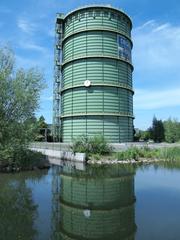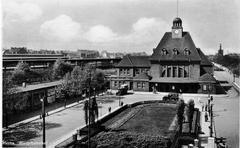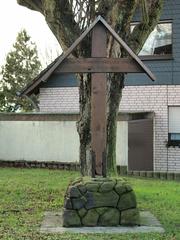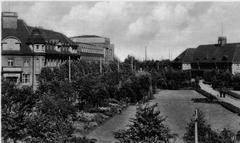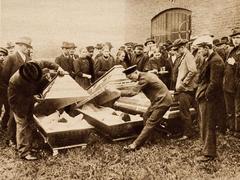
Zeche Teutoburgia: Visiting Hours, Tickets, and Historical Significance in Herne
Date: 04/07/2025
Introduction
Zeche Teutoburgia, nestled in the heart of Herne in the Ruhrgebiet, stands as a remarkable testament to Germany’s industrial heritage. Founded in 1866, this former coal mine was instrumental in the growth of the region’s steel and iron industries, shaping the working and social lives of thousands. Today, the site offers a unique blend of preserved industrial architecture, model workers’ housing inspired by the Garden City movement, and vibrant cultural spaces like the Kunstwald (Art Forest). Whether you are interested in history, architecture, or contemporary culture, Zeche Teutoburgia provides a multifaceted experience through its open-air grounds, guided tours, and dynamic events.
For up-to-date information on visiting hours, ticketing, accessibility, and special events, consult official resources such as the Ruhr Guide, Baukunst NRW, and Herne city tourism.
Table of Contents
- Introduction
- Historical Development and Industrial Significance
- Technical Equipment and Mining Operations
- The Miners’ Working and Living Conditions
- Decline and Closure
- Preservation, Repurposing, and Kunstwald Art Park
- Urban Planning and Architectural Features
- Cultural and Community Significance
- Visitor Information
- Nearby Attractions
- Frequently Asked Questions
- Visuals and Media
- Conclusion
Historical Development and Industrial Significance
Founded in 1866, Zeche Teutoburgia played a pivotal role in the coal mining industry of the Ruhrgebiet. Closely linked with the Bochumer Verein für Bergbau und Gußstahlfabrikation, the mine supplied essential resources for the steel and iron sectors. Key structures such as the headframe (Fördergerüst) and machine hall (Maschinenhalle) remain as enduring symbols of this industrial era (ruhr-guide.de).
Technical Equipment and Mining Operations
Zeche Teutoburgia operated multiple shafts, each dedicated to specific functions including coal extraction, ventilation, and personnel transport. Initially reliant on manual labor, the mine later adopted mechanical conveyor systems and mine railways to boost efficiency and safety. Over time, ongoing modernization efforts further improved operational standards.
The Miners’ Working and Living Conditions
Mining was physically demanding and hazardous. To address the welfare of miners and their families, the Teutoburgia Siedlung (settlement) was developed from 1909, showcasing progressive social housing with diverse architecture, communal facilities, and ample green spaces. This model estate remains under heritage protection today (baukunst-nrw.de).
Decline and Closure
Geological challenges and dwindling coal reserves led to periodic shutdowns, culminating in the mine’s permanent closure in 1983. Efforts to merge with neighboring operations could not ensure long-term viability.
Preservation, Repurposing, and Kunstwald Art Park
Following closure, the Zeche Teutoburgia site was revitalized as a cultural and event venue. The restored machine hall hosts concerts and exhibitions, while the Kunstwald features contemporary sculptures and installations set among thousands of newly planted trees and wildflowers (komoot.com).
Urban Planning and Architectural Features
The Teutoburgia settlement, constructed between 1909 and 1923, exemplifies early 20th-century industrial urban planning, deeply influenced by Ebenezer Howard’s Garden City principles. The estate’s layout integrates tree-lined avenues, green spaces, and communal courts, fostering a harmonious living environment (baukunst-nrw.de; thecrazytourist.com). Architect Kurt Berndt’s design includes 136 buildings with 459 residential units, reflecting the social hierarchy through varied house types and romantic historicist style. The Teutoburgiahof courtyard block, built after World War I, encourages community life with its shared spaces (wa.de).
Minimal war damage, careful restoration (1988–1998), and thoughtful modern expansions have preserved the estate’s unique character, earning it architectural accolades and ongoing recognition (DerWesten.de).
Cultural and Community Significance
Today, Zeche Teutoburgia is a vibrant community and cultural destination. Many residents are descendants of original miners, and local organizations such as the Friends of Teutoburgia maintain the site’s unique spirit. The headframe, now a city landmark, is illuminated at night, while the Kunstwald and machine hall offer cultural programming throughout the year.
The site is also a key stop on the Route der Industriekultur (Industrial Heritage Trail), connecting visitors to the broader history of the Ruhrgebiet (ruhrgebiet-industriekultur.de). Educational programs, art installations, and public events foster a lively atmosphere and reinforce the estate’s role as a living monument to industrial heritage and social progress.
Visitor Information
Visiting Hours
- Outdoor Areas & Settlement: Open year-round, accessible at all times.
- Museum & Visitor Center: Typically open Tuesday to Sunday, 10:00 AM to 5:00 PM. Event schedules may vary; check the official website before visiting.
- Machine Hall & Special Events: Accessible during concerts, exhibitions, and guided tours; consult event listings for details.
Tickets and Entry
- Outdoor Areas: Free access; no ticket required.
- Guided Tours & Events: Tickets required for special events or guided tours. Purchase online or at the visitor center; discounts available for children, seniors, and groups (Ruhr Tourismus).
Accessibility
- Mobility: Estate paths are generally flat and suitable for wheelchairs and strollers; some historic buildings may have limited access.
- Assistance: Accessible facilities and support are available at the visitor center.
Getting There and Parking
- Public Transport: Regional trains and buses connect to Herne; local buses serve the Börnig district near the estate.
- By Car: Close to highways A42 and A43; street parking is available but can be limited during events.
- By Bicycle: Popular among cyclists; bike racks at entry points.
Coordinates: 51.5510793 latitude, 7.2711778 longitude (Hikersbay).
Visitor Amenities
- Restrooms: Limited; available during events or at local cafes.
- Cafés/Restaurants: Several nearby; options are more limited than city centers.
- Accommodation: Local options include Casa Teutoburgia and other apartments (Hikersbay).
- Picnic Areas: Green spaces suitable for picnics.
Guided Tours and Special Events
Guided tours provide in-depth historical and architectural context, offered periodically or during special events. The machine hall is a cultural hub, hosting concerts, sound installations, and exhibitions curated by artists like Christof Schläger (komoot.com). Check the Herne city website or Ruhr Tourismus for current schedules and bookings.
Nearby Attractions
- Schloss Bladenhorst: Historic castle accessible by foot or bike (Komoot).
- Rhein-Herne Canal: Scenic for walking and cycling.
- LWL-Museum für Archäologie: Regional archaeology museum.
- Revierpark Gysenberg: Parks and recreation.
Frequently Asked Questions (FAQ)
Q: Are there entrance fees?
A: Outdoor areas are free; guided tours and events may require tickets.
Q: What are the opening hours?
A: Outdoor areas are open 24/7; museums/events have specific hours.
Q: Is Zeche Teutoburgia accessible?
A: Yes, most paths are suitable for wheelchairs; some historic buildings have limited access.
Q: Can I bring my dog?
A: Assistance dogs are welcome; other dogs must be leashed.
Q: Are guided tours available?
A: Yes, especially during cultural events; check official listings for schedules.
Visuals and Media
Visitors can enjoy interactive maps, virtual tours, and photo galleries online. The estate’s iconic headframe, restored machine hall, and contemporary art in the Kunstwald offer striking photo opportunities (ruhr-guide.de; inherne.net).
Summary and Visitor Tips
Zeche Teutoburgia exemplifies the Ruhrgebiet’s transformation from industrial powerhouse to cultural landscape. Its blend of architectural heritage, community life, and cultural programming makes it a standout destination. Visitors are encouraged to check current visiting hours, event schedules, and accessibility options via Ruhr Tourismus and the Route der Industriekultur. For an enhanced experience, download the Audiala app for interactive guides and up-to-date information.
Further Resources
- Ruhr Guide: Zeche Teutoburgia
- Baukunst NRW: Siedlung Teutoburgia
- Herne Damals & Heute: Zeche Teutoburgia
- Ruhr Tourismus: Siedlung Teutoburgia
- Route der Industriekultur
- WA: Teutoburgia Overview
- Herne Tourism: Teutoburgia Siedlung


